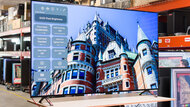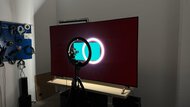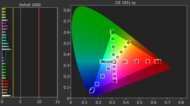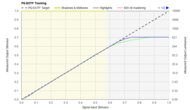You can find a wide selection of TVs below $1,000. More and more high-end TVs are available for under $1,000, and even though you can usually only find some smaller models for this price if you want the best performance, a few decent, larger models are available if you'd rather have a bigger screen. Some companies make low-cost TVs with good value, but it's hard to determine which models are the best option for your money. Through testing dozens of TVs each year, we're able to see which models in this price range are worth buying.
Below are our recommendations for the best TVs under $1,000. See our picks for the best TVs, the best TVs under $500, and the best TVs under $1,500 for more options. You can also vote on which ones you want us to buy and test. To learn more about the 2025 models, check out our 2025 TV lineup page.
Quick Look





We buy and test dozens of TVs yearly, taking an objective, data-driven approach to deliver results you can trust. Our testing process is complex, with hundreds of individual tests that take over a week to complete. Most of our tests are done with specially designed test patterns that mimic real content, but we also use the same sources you have at home to ensure our results match the real-world experience. We use two main tools for our testing: a Colorimetry Research CR-100 colorimeter and a CR-250 spectroradiometer.
-
Best TV Under $1,000
 Home Theater8.4Bright Room6.7Gaming8.5Mixed Usage8.2Sports7.1Brightness7.0Black Level10Color8.3Processing (In Development)8.3Game Mode Responsiveness9.0Resolution4kNative Refresh Rate120HzScreen FinishGlossyTypeOLEDSub-TypeWOLEDSee all our test resultsDolby VisionYes
Home Theater8.4Bright Room6.7Gaming8.5Mixed Usage8.2Sports7.1Brightness7.0Black Level10Color8.3Processing (In Development)8.3Game Mode Responsiveness9.0Resolution4kNative Refresh Rate120HzScreen FinishGlossyTypeOLEDSub-TypeWOLEDSee all our test resultsDolby VisionYesThe best TV under $1,000 we've tested is the LG B5 OLED. The 48-inch model is regularly sold for less than $1,000, and the 55-inch model is also sold for just under that price during sales, making it the best 55-inch TV under $1,000 when you can find it for that price. The TV is a standout option due to its incredible picture quality and wealth of features, and it easily outperforms almost any other model in this price range. It displays inky blacks in a dark room with absolutely no haloing around highlights. The TV also has enough HDR brightness to make highlights stand out well in HDR content. Furthermore, colors are vibrant and accurate, so it delivers a solid HDR viewing experience. It's a bit dim in SDR, but it's just bright enough to handle glare from overhead lights in a moderately lit room. Being an OLED, it has a wide viewing angle, making it suitable for large living rooms with seating that's off to the sides of the screen.
On top of great image quality, you get a ton of features. The built-in webOS is loaded with apps, so finding content to watch is easy, and you don't need a dedicated streaming box. It supports the popular Dolby Vision HDR format, but it doesn't passthrough DTS audio formats. It's also a fantastic option for gaming, thanks to its nearly instantaneous pixel transitions that deliver crystal-clear motion, HDMI 2.1 bandwidth on all four ports, and 4k @ 120Hz gaming with VRR.
-
Best Mid-Range TV Under $1,000
 Home Theater7.9Bright Room8.0Gaming7.8Mixed Usage7.8Sports7.9Brightness7.8Black Level8.4Color7.5Processing (In Development)7.7Game Mode Responsiveness8.0Resolution4kNative Refresh Rate144HzScreen FinishGlossyTypeLEDSub-TypeVASee all our test resultsDolby VisionYes
Home Theater7.9Bright Room8.0Gaming7.8Mixed Usage7.8Sports7.9Brightness7.8Black Level8.4Color7.5Processing (In Development)7.7Game Mode Responsiveness8.0Resolution4kNative Refresh Rate144HzScreen FinishGlossyTypeLEDSub-TypeVASee all our test resultsDolby VisionYesIf you prefer something cheaper than the LG B5 OLED or don't need the best of the best, consider the TCL QM7K, the best 65-inch TV under $1,000 when on sale. Although it doesn't quite match the perfect black levels of OLED displays, this TV still offers impressive picture quality that should satisfy most viewers. Its local dimming works well, producing deep, bold blacks, though there's some haloing around subtitles and some highlights. HDR content has vibrant colors and highlights that stand out well, delivering an impactful experience. In SDR, the TV is exceptionally bright and manages indirect reflections effectively, making it a solid choice for well-lit rooms. However, it's a good idea to avoid placing light sources directly opposite the screen, as those are quite visible on the screen during most scenes.
It also comes equipped with a variety of modern gaming features. Two HDMI 2.1 ports support resolutions up to 4k @ 144Hz and 1080p @ 288Hz with VRR, making it a compelling option for gamers. While its pixel transitions don't quite match what you get with OLEDs, it still outpaces most LED TVs, keeping motion blur to a minimum. On top of those gaming features are Dolby Vision, HDR10+, and DTS Audio support. Furthermore, it runs the easy-to-use Google TV OS, which is loaded with apps and games. Unfortunately, picture quality degrades when viewed from the sides of the screen due to its narrow viewing angle, which is a drawback in wide seating setups.
-
Best Budget TV Under $1,000
 Home Theater7.2Bright Room7.0Gaming7.2Mixed Usage7.1Sports7.1Brightness6.5Black Level7.6Color7.2Processing (In Development)7.0Game Mode Responsiveness7.9Resolution4kNative Refresh Rate144HzScreen FinishGlossyTypeLEDSub-TypeVASee all our test resultsDolby VisionYes
Home Theater7.2Bright Room7.0Gaming7.2Mixed Usage7.1Sports7.1Brightness6.5Black Level7.6Color7.2Processing (In Development)7.0Game Mode Responsiveness7.9Resolution4kNative Refresh Rate144HzScreen FinishGlossyTypeLEDSub-TypeVASee all our test resultsDolby VisionYesIf you're on a strict budget or you're looking for the best 75-inch TV under $1,000 specifically, the TCL QM6K is a great choice. Although it doesn't have the image quality of the TCL QM7K, this TV still delivers a visually pleasing experience that will impress most people. Colors are somewhat muted, but remain vibrant enough to avoid looking washed out. Blacks aren't as deep, but they are still bold enough due to the TV's solid local dimming. The TV is bright enough in SDR to combat glare in well-lit rooms. However, its lower HDR brightness means highlights don't stand out as much as they should in HDR movies, shows, and games. Despite this, the overall HDR experience is still decent. Like its more expensive sibling, it has a narrow viewing angle, so you get the best image quality when sitting directly in front of the screen.
Fortunately, it offers the same core features as its more expensive sibling, including two HDMI 2.1 ports, support for 4k @ 144Hz, 1080p @ 288Hz, VRR, Dolby Vision, HDR10+, and DTS audio passthrough. This means that while the image quality is not quite at the same level, it has the same set of features. It also runs the same version of Google TV, providing access to a large library of apps and games. For a TV at this price point, you certainly don't lose out on high-end features, and you still get a TV with solid image quality.
-
Best Large Cheap TV Under $1,000
 Home Theater5.8Bright Room6.3Gaming6.2Mixed Usage6.0Sports6.0Brightness5.6Black Level4.9Color6.8Processing (In Development)6.3Game Mode Responsiveness6.7Resolution4kNative Refresh Rate60HzScreen FinishGlossyTypeLEDSub-TypeVASee all our test resultsDolby VisionYes
Home Theater5.8Bright Room6.3Gaming6.2Mixed Usage6.0Sports6.0Brightness5.6Black Level4.9Color6.8Processing (In Development)6.3Game Mode Responsiveness6.7Resolution4kNative Refresh Rate60HzScreen FinishGlossyTypeLEDSub-TypeVASee all our test resultsDolby VisionYesIf you're looking for a cheap TV for under $1,000 and want the biggest option for the lowest possible cost, consider the Hisense QD6QF. It's available in a wide range of sizes, and you can regularly purchase the 85-inch model for just under $1,000. It's just bright enough to handle glare in a moderately lit room, but it's too dim in HDR to truly make highlights stand out, which leads to a lackluster HDR experience. It displays a wide range of colors, so the image doesn't look too muted, but it struggles to display very dark and very bright colors. Furthermore, blacks look gray since the TV doesn't have local dimming. Like the TCL models above, it has a narrow viewing angle, so it only looks its best when you're centered to the screen.
Even though it's cheap, the TV supports Dolby Vision and HDR10+. It even passes through DTS audio formats, so it has great compatibility. The TV is limited to HDMI 2.0 bandwidth, so you're limited to 4k @ 60Hz, but it does support VRR to reduce screen tearing. Pixel transitions are on the slower side, which leads to apparent motion blur in fast games, but it's totally fine for casual gamers. All in all, it's not a great TV, but it gets the job done.
Notable Mentions
-
LG OLED42C5PUA:
If you're specifically looking for a smaller OLED and wish the LG B5 OLED were brighter, go with the 42-inch LG C5 OLED. The C5 also supports a 144Hz refresh rate and has superior low-quality content smoothing, making it the better TV overall. However, you can typically only find the 42-inch model for under $1,000, so the B5 is better for those looking for something larger.
See our review -
Hisense 65U75QG:
The Hisense U75QG is similar to the TCL QM7K but offers a higher peak brightness. On the downside, it makes HDR content look brighter than intended and exhibits more noticeable motion blur due to slower pixel transitions. Due to clearer motion, superior black levels, and support for 1080p @ 288Hz, the TCL is the better TV overall.
See our review -
Hisense 75U65QF:
The Hisense U65QF offers more brightness compared to the TCL QM6K, but it tends to overbrighten HDR content, causing it to deviate from the content creator's intent. In comparison, the TCL provides a more balanced experience with deeper blacks, better overall accuracy, and support for 1080p @ 288Hz.
See our review -
TCL 85S551G:
The TCL S551G is an alternative to the Hisense QD6QF for gamers who care most about performance. The TCL offers 1080p and 1440p @ 120Hz with VRR and low input lag, so it's a solid option for those who want to game in 120 fps. However, the Hisense has better picture quality, so it's the better TV for most people looking for a cheap model.
See our review
Recent Updates
Nov 13, 2025:
Replaced the LG B4 OLED with the LG B5 OLED as our top pick, and replaced the TCL Q651G with the Hisense QD6QF in the 'Best Cheap' category.
Aug 07, 2025:
Replaced the Hisense U8N with the TCL QM7K in the 'Best Mid-Range' category, the Hisense U6N with the TCL QM6K in the 'Best Budget' category, and the TCL S551G with the TCL Q651G in the 'Best Large Cheap TV' category. We also refreshed some text throughout for clarity and updated the Notable Mentions section.
May 14, 2025:
We added a link to our 2025 TV lineup article and confirmed the availability of our current picks.
Jan 07, 2025:
We replaced the TCL S4/S450G with the TCL S5/S551G in the 'Best Large Cheap TV Under $1,000' category and added the Hisense U7N as a Notable Mention.
Oct 09, 2024: Replaced the LG C3 OLED with the LG B4 OLED as our new top pick and swapped the Hisense U8/U8K and the Hisense U6/U6K with their 2024 successors.
All Reviews
Our recommendations above are what we think are currently the best TVs you can get for under $1,000, including the best 65-inch TV under $1,000 and the best 75-inch TV under $1,000. We factor in the price (a cheaper TV wins over a pricier one if the difference isn't worth it), feedback from our visitors, and availability (no TVs that are difficult to find or almost out of stock everywhere).
If you would like to do the work of choosing yourself, here is the list of all TVs under $1,000. Be careful not to get too caught up in the details. While no TV is perfect, most TVs are great enough to please almost everyone, and the differences are often not noticeable unless you really look for them. Also, keep in mind that our scores aren't comparable across different test benches, so most of the TVs in the list below score higher than they would today.












